小学英语常用介词用法
小学英语语法知识归纳总结介词

小学英语语法知识归纳总结介词介词是连接名词、代词或其他类似词语与其前面的词之间关系的词。
以下是小学英语中常见的一些介词及其用法:1. in :表示在一些地点或地区e.g. Tom is in the park.(汤姆在公园里。
)2. on :表示在一些表面、平台或日期e.g. The book is on the table.(这本书在桌子上。
)I was born on April 10th.(我出生在4月10日。
)3. at :表示在一些具体的时间、地点或事件e.g. She arrived at the school at 8 o'clock.(她八点到达学校。
)4. from :表示从一些地点、时间或人那里得到或来自e.g. I received a gift from my friend.(我收到了一份来自朋友的礼物。
)5. to :表示目的地或方向e.g. We are going to the beach.(我们要去海滩。
)6. with :表示伴随或使用物e.g. She went to the park with her friends.(她和朋友一起去了公园。
)7. for :表示为了一些目的或对象e.g. I bought a cake for my mom's birthday.(我为我妈妈的生日买了一个蛋糕。
)8. by :表示通过其中一种方式或交通工具e.g. I go to school by bus every day.(我每天坐公交车去学校。
)9. about :表示关于一些话题或主题e.g. We had a discussion about our summer vacation plans.(我们就暑假计划进行了一次讨论。
)10. to :表示直接的动作对象或方向e.g. I gave the present to my best friend.(我把礼物给了我最好的朋友。
小学英语介词短语(好)
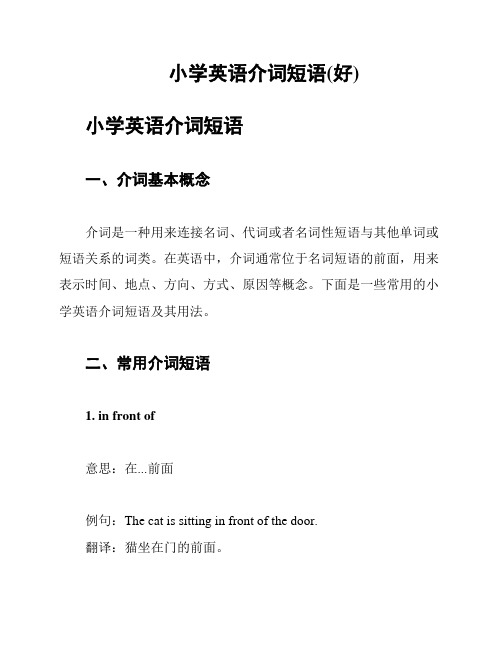
小学英语介词短语(好)小学英语介词短语一、介词基本概念介词是一种用来连接名词、代词或者名词性短语与其他单词或短语关系的词类。
在英语中,介词通常位于名词短语的前面,用来表示时间、地点、方向、方式、原因等概念。
下面是一些常用的小学英语介词短语及其用法。
二、常用介词短语1. in front of意思:在...前面例句:The cat is sitting in front of the door.翻译:猫坐在门的前面。
2. at school意思:在学校例句:I study English at school.翻译:我在学校学英语。
3. on the table意思:在桌子上例句:The book is on the table.翻译:书在桌子上。
4. under the tree意思:在树下例句:We had a picnic under the tree. 翻译:我们在树下野餐。
5. with a friend意思:和朋友在一起例句:I like playing soccer with a friend. 翻译:我喜欢和朋友一起踢足球。
6. by the beach意思:在海滩旁边例句:They built sandcastles by the beach. 翻译:他们在海滩旁边堆沙堡。
7. for breakfast意思:作为早餐例句:I had cereal for breakfast.翻译:我吃了谷物当早餐。
8. after school意思:放学后例句:Let's go to the park after school. 翻译:放学后我们去公园。
9. in the morning意思:在早晨例句:I like to jog in the morning.翻译:我喜欢早晨慢跑。
10. with a smile意思:带着微笑例句:She always greets everyone with a smile.翻译:她总是带着微笑向每个人打招呼。
小学英语语法-介词

小学英语语法-介词介词的定义介词是一种表示名词或代词与其他词之间关系的词类。
它可以表示时间、地点、方式、原因等关系。
常见的介词以下是小学英语中常见的介词及其用法:in:表示在某个地点或某个范围内。
例如:in the park(在公园里)、in the morning(在早上)。
in:表示在某个地点或某个范围内。
例如:in the park(在公园里)、in the morning(在早上)。
in:表示在某个地点或某个范围内。
例如:in the park(在公园里)、in the morning(在早上)。
on:表示在某个表面或某个特定日期。
例如:on the desk(在桌子上)、___(在星期一)。
on:表示在某个表面或某个特定日期。
例如:on the desk(在桌子上)、___(在星期一)。
on:表示在某个表面或某个特定日期。
例如:on the desk(在桌子上)、___(在星期一)。
at:表示在具体的时间或某个地点。
例如:at 7 o'clock(在7点)、___(在学校)。
at:表示在具体的时间或某个地点。
例如:at 7 o'clock(在7点)、___(在学校)。
at:表示在具体的时间或某个地点。
例如:at 7 o'clock(在7点)、___(在学校)。
to:表示向某个地点或某个目标。
例如:go to the supermarket (去超市)。
to:表示向某个地点或某个目标。
例如:go to the supermarket(去超市)。
to:表示向某个地点或某个目标。
例如:go to the supermarket(去超市)。
from:表示从某个地点或某个时间开始。
例如:___(从星期一到星期五)。
from:表示从某个地点或某个时间开始。
例如:___(从星期一到星期五)。
from:表示从某个地点或某个时间开始。
例如:___(从星期一到星期五)。
by:表示通过某种方式或某个工具。
小学英语介词用法总结

小学英语介词用法总结at,on和in是表示时间的常用介词,各类考试屡见踪影,也是孩子容易出错的考点:即at某时刻, on某天, in某段时间,时间的跨度是由小到大。
01选用介词at的场合介词at主要可用于以下几种场合,家长需提醒孩子特别注意的是at在固定短语或习惯搭配中的使用。
用于钟点前·at ten o’clock·at a quarter to six用于时刻前·at noon/night/midnight(半夜)·at sunrise(日出时)·at dusk(黄昏)·at dawn/daybreak(黎明)eg:We will leave at daybreak.我们将在黎明时动身。
用于表示进餐时间。
如:·at breakfast/lunch/supper(在早餐时/午餐时/晚餐时) eg:He drinks tea at breakfast.他在早餐时饮茶。
用于表示年龄时。
如:·at 14(= at the age of14在14岁)eg: He left home at the age of 16.他十六岁离开了家。
用于一些固定短语或习惯搭配中。
如:·at Christmas·at New Year·at Thanksgiving (感恩节)·at the beginning/end of last month·at the moment/ at that time·at this time of day·at a bad time of year·at first (起初)·at last (终于)02选用介词on的场合用于星期、日期(包括该天的各部分)前·on Sundays/weekdays·on Monday morning / afternoon / eveningeg:I'm flying home on Sunday afternoon. 我星期四下午乘飞机回家。
小学英语常用介词用法

小学英语常用介词2)after(在……之后):after breakfast 早饭后,after school 放学后,after class 课后3)before(在……之前):before class 课前,before lunch 午饭前4)at(在):at home在家,at school 在学校,at work 在工作。
5)in(在……里面;用;戴):in English 用英语,in a hat 戴帽子,in front of 在……前面,in line 排成一行,in the end 最后,in the open air 在野外,in a minute立刻,in surprise 惊奇地,in time及时,in trouble 处在困难中。
6)on(在、关于):on one’s way home 回家路上,on duty 值日,on foot 步行,on top of 在……上面。
on the earth 在地球上。
7)under(在……下面):under the desk 在书桌下,under the tree 在树下8)between(在两者之间):between the two children 在两个孩子之间,between A and B 在A 和B之间。
9)beside(在……旁边):sit beside her 坐在她身边,beside the river 在河边。
10)behind(在……后面):behind the house 在房子后面,behind the door 在门后。
11)near(在……附近):near the river 在河边,stand near the door 站在门旁。
12)into(在……里):come into the classroom 进入教室,fall into the water 掉进水里13)outside (在……之外):outside of gate 在大门外。
小学英语介词汇总
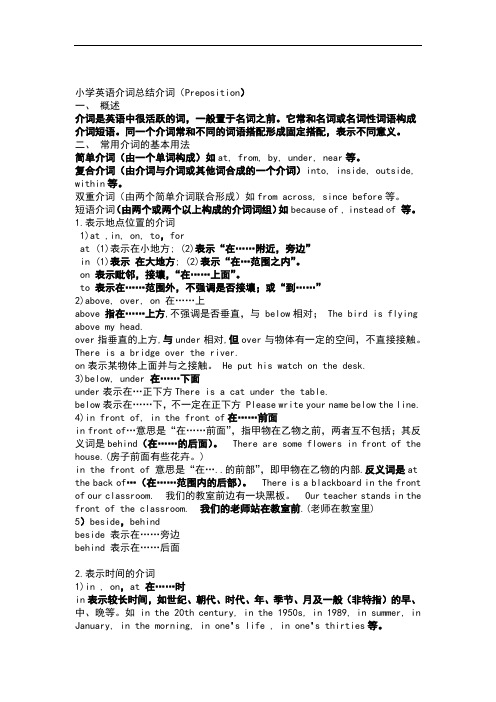
小学英语介词总结介词(Preposition)一、概述介词是英语中很活跃的词,一般置于名词之前。
它常和名词或名词性词语构成介词短语。
同一个介词常和不同的词语搭配形成固定搭配,表示不同意义。
二、常用介词的基本用法简单介词(由一个单词构成)如at, from, by, under, near等。
复合介词(由介词与介词或其他词合成的一个介词)into, inside, outside, within等。
双重介词(由两个简单介词联合形成)如from across, since before等。
短语介词(由两个或两个以上构成的介词词组)如because of , instead of 等。
1.表示地点位置的介词1)at ,in, on, to,forat (1)表示在小地方; (2)表示“在……附近,旁边”in (1)表示在大地方; (2)表示“在…范围之内”。
on 表示毗邻,接壤,“在……上面”。
to 表示在……范围外,不强调是否接壤;或“到……”2)above, over, on 在……上above 指在……上方,不强调是否垂直,与 below相对; The bird is flying above my head.over指垂直的上方,与under相对,但over与物体有一定的空间,不直接接触。
There is a bridge over the river.on表示某物体上面并与之接触。
He put his watch on the desk.3)below, under 在……下面under表示在…正下方There is a cat under the table.below表示在……下,不一定在正下方 Please write your name below the line.4)in front of, in the front of在……前面in front of…意思是“在……前面”,指甲物在乙物之前,两者互不包括;其反义词是behind(在……的后面)。
小学英语介词的用法总结

介词的用法1 .表示地点位置的介词1)at ,in, on, to, forat⑴表示在小地方;(2)表示“在……附近,旁边”in⑴表示在大地方;(2)表示“在.一范围之内”。
on表示毗邻,接壤,“在……上面”。
to表示在……范围外,不强调是否接壤;或“到……”2)above, over, on 在……上above指在……上方,不强调是否垂直,与below相对;over指垂直的上方,与under相对,但over与物体有一定的空间,不直接接触。
on表示某物体上面并与之接触。
The bird is flying above my head. There is a bridge over the river.He put his watch on the desk.3)below, under 在... 下面under表示在…正下方below表示在……下,不一定在正下方There is a cat under the table.Please write your name below the line.4)in front [frant]of, in the front of 在..... 前面in front of…意思是“在……前面”,指甲物在乙物之前,两者互不包括;其反义词是behind (在.. 的后面)。
There are some flowers in front of the house.(房子前面有些花卉。
)in the front of意思是"在…..的前部”,即甲物在乙物的内部.反义词是at the back of…(在……范围内的后部)。
There is a blackboard in the front of our classroom.我们的教室前边有一块黑板。
Our teacher stands in the front of the classroom.我们的老师站在教室前.(老师在教室里)5)beside,behindbeside表示在... 旁边behind表示在... 后面2 .表示时间的介词1)in , on,at 在... 时in表示较长时间,如世纪、朝代、时代、年、季节、月及一般(非特指)的早、中、晚等。
小学英语介词总结
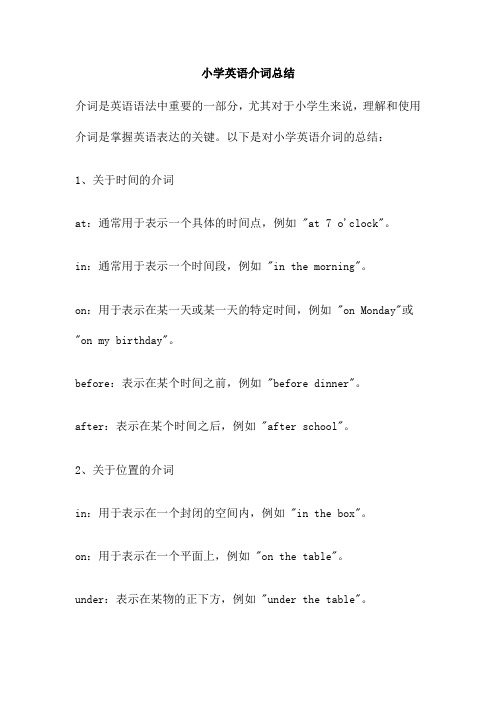
小学英语介词总结介词是英语语法中重要的一部分,尤其对于小学生来说,理解和使用介词是掌握英语表达的关键。
以下是对小学英语介词的总结:1、关于时间的介词at:通常用于表示一个具体的时间点,例如 "at 7 o'clock"。
in:通常用于表示一个时间段,例如 "in the morning"。
on:用于表示在某一天或某一天的特定时间,例如 "on Monday"或"on my birthday"。
before:表示在某个时间之前,例如 "before dinner"。
after:表示在某个时间之后,例如 "after school"。
2、关于位置的介词in:用于表示在一个封闭的空间内,例如 "in the box"。
on:用于表示在一个平面上,例如 "on the table"。
under:表示在某物的正下方,例如 "under the table"。
above:表示在某物的上方,但是不一定是正上方,例如 "above the table"。
beside:表示在某物的旁边,例如 "beside the book"。
3、关于方向的介词to:用于表示朝向某个方向或地点,例如 "go to school"。
from:用于表示从一个地方或位置到另一个地方或位置,例如 "come from school"。
towards:表示朝向某个方向或地点,但是不一定到达那里,例如"walk towards the park"。
4、关于原因的介词because:用于表示原因或理由,例如 "I am late because I missed the bus"。
小学的归纳与解析常见介词的用法和搭配规则
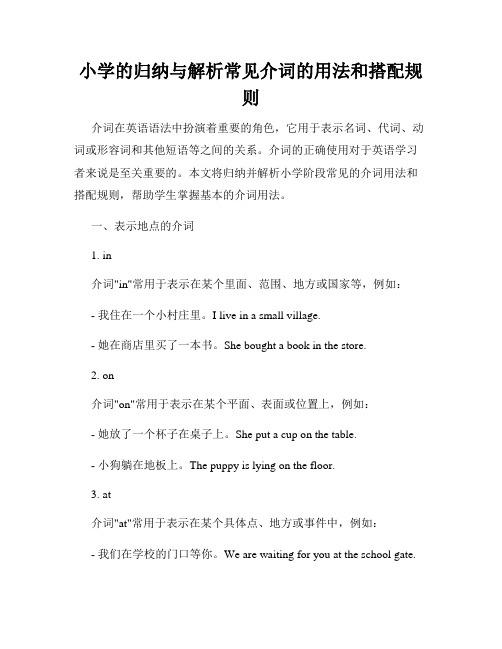
小学的归纳与解析常见介词的用法和搭配规则介词在英语语法中扮演着重要的角色,它用于表示名词、代词、动词或形容词和其他短语等之间的关系。
介词的正确使用对于英语学习者来说是至关重要的。
本文将归纳并解析小学阶段常见的介词用法和搭配规则,帮助学生掌握基本的介词用法。
一、表示地点的介词1. in介词"in"常用于表示在某个里面、范围、地方或国家等,例如:- 我住在一个小村庄里。
I live in a small village.- 她在商店里买了一本书。
She bought a book in the store.2. on介词"on"常用于表示在某个平面、表面或位置上,例如:- 她放了一个杯子在桌子上。
She put a cup on the table.- 小狗躺在地板上。
The puppy is lying on the floor.3. at介词"at"常用于表示在某个具体点、地方或事件中,例如:- 我们在学校的门口等你。
We are waiting for you at the school gate.- 她在图书馆参加了一个讲座。
She attended a lecture at the library.二、表示时间的介词1. in介词"in"常用于表示在某个时间段或月份中,例如:- 我在冬天喜欢滑雪。
I enjoy skiing in winter.- 我们将在十二月举办一次聚会。
We will have a party in December.2. on介词"on"常用于表示在某个具体日期或星期几,例如:- 他们将在星期五晚上去看电影。
They will go to the movies on Friday night.- 我的生日是在七月二十一日。
My birthday is on July 21st.3. at介词"at"常用于表示在某个具体时间点,例如:- 晚上九点钟我会在家里等你。
(完整版)小学英语常用介词及用法
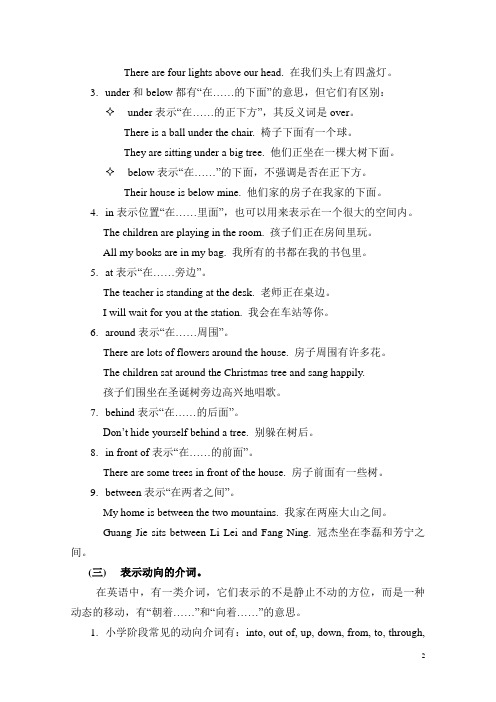
常见介词及用法(一)表示时间的介词1.英语里最常见的时间介词有:at, in, on, before, after和from。
2.at , in和on这三个词都表示时间。
✧at主要指具体的钟点:at half past eight 在八点半✧in一般指某一段时间:in January 在一月份✧on指具体在某一天:on Monday 在星期一3.before和after表示时间的先后顺序。
✧before表示“在……之前”。
You should wash your hands before eating. 吃饭前你应该洗手。
✧after表示“在……之后”。
They often play basketball after dinner. 他们放学后经常打篮球。
4.from作时间介词含有“从……开始”的意思,常和to连用,组成“from…to…”的结构,表示“从……到……”的意思。
We go to school from Monday to Friday. 我们从周一到周五上学。
(二)表示方位的介词,也就是表示位置和地点的介词。
1.小学阶段常见的方位介词有:on, in, at, under, over, above, below, about,around, between等。
2.on, over和above这三个词都有“在……上面”的意思,但它们所表示的方位还是有些不同。
✧on表示两个物体的表面相互接触。
如:There is a book on the desk. 桌上有一本书。
The boy is sleeping on the desk. 那个孩子睡在地上。
✧over表示“在……的正上方”,两个物体表面没有接触。
如:There is a light bulb over my head. 在我头顶上有一个灯泡。
✧above表示两个物体中一个在另一个的上方,如:The plane is flying above the clouds. 飞机上云层上飞行。
小学英语常用介词用法

小学英语常用介词用法在学习英语的过程中,掌握介词的正确用法是非常重要的。
介词是连接词与词之间关系的一种词类,它能够表示时间、地点、方式、原因等等。
在小学英语中,常用的介词有很多,下面将为大家介绍一些常用的介词及其用法。
1. in介词"in"用于表示在某个范围内或在某个具体的位置上。
例如:- I live in a house.- There is a book in the bag.2. on介词"on"用于表示在某个表面上。
例如:- The cup is on the table.- The picture is on the wall.3. at介词"at"用于表示在某个点、位置或地方。
例如:- He is waiting at the bus stop.- We will meet at the park.4. by介词"by"用于表示通过某种方式或手段。
例如:- I go to school by bus.- They communicate by email.5. for介词"for"用于表示目的、原因或表示给予的对象。
例如:- This gift is for you.- I study hard for good grades.6. with介词"with"用于表示陪伴或伴随的状态。
例如:- She went to the park with her friends.- He plays basketball with his brother.7. to介词"to"用于表示目的、方向、接触等。
例如:- I go to school every day.- She gives a present to her teacher.8. from介词"from"用于表示出发地、来源或起点。
常用介词在小学英语中的运用

常用介词在小学英语中的运用介词在英语中起着连接词语的作用,常用于表示位置、方向、时间、原因、目的等。
在小学英语研究中,合理运用常用介词能够帮助学生更好地理解和运用英语。
以下是一些常用介词及其在小学英语中的运用场景。
1. In介词 "in" 表示在某个位置、地点或区域之内。
使用场景:- 表示身体部位:in my hand(在我手上)、in my pocket(在我口袋里)- 表示在某个建筑物里:in the house(在房子里)、in the classroom(在教室里)- 表示在某个国家或城市内:in China(在中国)、in Shanghai (在上海)2. On介词 "on" 表示在一个表面、平面或位置之上。
使用场景:- 表示在某个物体上:on the table(在桌子上)、on the chair (在椅子上)- 表示在某个交通工具上:on the bus(在公交车上)、on the bike(在自行车上)- 表示在某个日期或天气上:on Monday(在星期一)、on a rainy day(在雨天)3. At介词 "at" 表示在一个具体的地点、时间或事件中。
使用场景:- 表示在某个具体地点:at school(在学校)、at the park(在公园)- 表示在某个具体时间:at 8 o'clock(在8点)、at night(在晚上)- 表示参加某个活动或事件:at a party(在聚会上)、at a concert(在音乐会上)4. For介词 "for" 表示表示目的、原因或持续时间。
使用场景:- 表示某个目的:study for the test(为了考试而研究)、buy a gift for mom(买礼物给妈妈)- 表示原因:thank you for your help(因为你的帮助而感谢你)、apologize for the mistake(为错误向他人道歉)- 表示持续时间:for two hours(持续两小时)、for a long time (持续很长时间)以上是常用介词在小学英语中的运用。
小学英语介词总结

小学英语介词总结介词是英语中非常重要的一部分,它有着非常多的用途和作用。
所以,学习英语的小学生们必须掌握这些介词的用法,才能够在以后的语言学习中更好地运用这些词汇。
下面,我们就来总结一下小学英语中常用的介词。
1. In“In”这个介词常常用于表示“在……之内”的意思。
比如说,“in the classroom”表示在教室里,“in the box”表示在盒子里,“in the park”表示在公园里。
2. On“On”这个介词则表示“在……之上”的意思。
比如说,“on the table”表示在桌子上,“on the floor”表示在地板上,“on the chair”表示在椅子上。
3. Under“Under”这个介词则是表示“在……下面”的意思。
比如说,“under the bed”表示在床底下,“under the tree”表示在树下,“under the desk”表示在桌子下面。
4. Beside“Beside”这个介词则是表示“在……旁边”的意思。
比如说,“beside the window”表示在窗户旁边,“beside the door”表示在门旁边,“beside the road”表示在路边。
5. Behind“Behind”这个介词则表示“在……后面”的意思。
比如说,“behind the building”表示在建筑物后面,“behind the chair”表示在椅子后面,“behind the tree”表示在树后面。
6. Above“Above”这个介词则表示“在……上面”的意思。
比如说,“above the clouds”表示在云层之上,“above the sky”表示在天空之上,“above the mountain”表示在山顶之上。
7. Below“Below”这个介词则表示“在……下面”的意思。
比如说,“below the sea”表示在海底,“below the ground”表示在地底,“below the surface”表示在表面之下。
小学英语介词总结
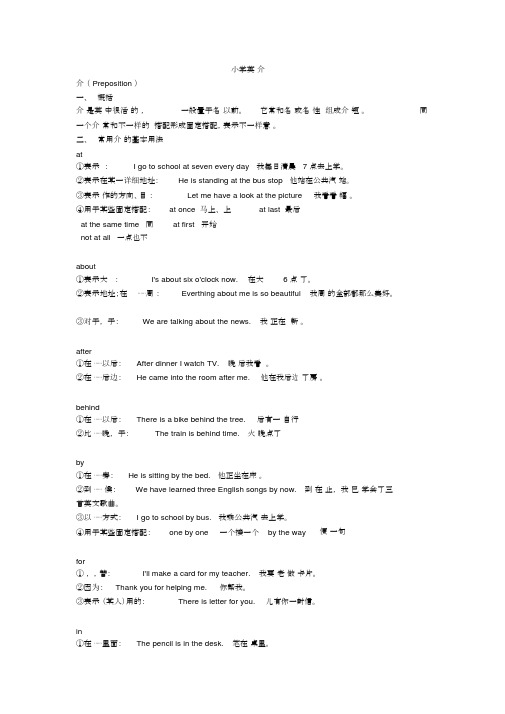
小学英介介( Preposition )一、概括介是英中很活的,一般置于名以前。
它常和名或名性组成介短。
同一个介常和不一样的搭配形成固定搭配,表示不一样意。
二、常用介的基本用法at①表示:I go to school at seven every day我每日清晨7 点去上学。
②表示在某一详细地址:He is standing at the bus stop他站在公共汽站。
③表示作的方向、目:Let me have a look at the picture我看看幅。
④用于某些固定搭配:at once 马上、上at last 最后at the same time同at first开始not at all一点也不about①表示大:I's about six o'clock now.在大 6 点了。
②表示地址;在⋯⋯周:Everthing about me is so beautiful我周的全部都那么美好。
③对于,于:We are talking about the news.我正在新。
after①在⋯⋯以后:After dinner I watch TV.晚后我看。
②在⋯⋯后边:He came into the room after me.他在我后边了房。
behind①在⋯⋯以后:There is a bike behind the tree.后有一自行②比⋯⋯晚,于:The train is behind time.火晚点了by①在⋯⋯旁:He is sitting by the bed.他正坐在床。
②到⋯⋯ 候:We have learned three English songs by now.到在止,我已学会了三首英文歌曲。
③以⋯⋯方式:I go to school by bus.④用于某些固定搭配:one by one 我乘公共汽去上学。
一个接一个by the way便一句for① ,,替:I'll make a card for my teacher.我要老做卡片。
小学英语常考介词

小学英语常考介词介词一般置于名词之前,它常和名词或名词性词语构成介词短语。
同一个介词和不同的词语搭配形成固定搭配,表示不同的意义。
一、常考时间介词at,on,in时间介词at,on,in后面都可以接表示时间的词,但用法又有所不同。
1、时间介词at的用法:(1)at+具体时刻/时间点。
如:at six o'clock ;at a quarter to eight ;at half past nine(2)at+某个时段。
如:at noon/night ;at weekends(3)at+节日。
如:at Christmas(4)at+年龄。
如:at ten/at the age of ten例:Peter usually gets up at 7 o'clock in the morning.PeterThe clock strikes twelve times at noon.We'll see you at Christmas.She left her hometown at fourteen.(1)on+星期。
如:on Monday ;on Friday(2)on+具体日期。
如:on May 21st(3)on+具体某天的上午/下午/晚上。
如:on Saturday evening on the morning of May 21st例:We have an English class on Thursday.Mike's birthday is on March 9th.They will have a football game on the afternoon of April 11th.3、时间介词in的用法:(1)in+上午/下午/晚上。
如:in the morning/afternoon/evening(2)in+月份、季节、年份。
如:in October ;in spring ;in 2015(3)in+年龄。
小学英语 常用介词的用法
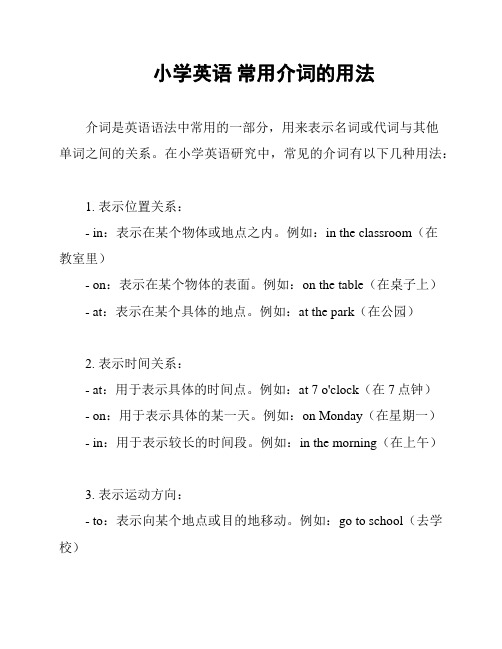
小学英语常用介词的用法介词是英语语法中常用的一部分,用来表示名词或代词与其他单词之间的关系。
在小学英语研究中,常见的介词有以下几种用法:1. 表示位置关系:- in:表示在某个物体或地点之内。
例如:in the classroom(在教室里)- on:表示在某个物体的表面。
例如:on the table(在桌子上)- at:表示在某个具体的地点。
例如:at the park(在公园)2. 表示时间关系:- at:用于表示具体的时间点。
例如:at 7 o'clock(在7点钟)- on:用于表示具体的某一天。
例如:on Monday(在星期一)- in:用于表示较长的时间段。
例如:in the morning(在上午)3. 表示运动方向:- to:表示向某个地点或目的地移动。
例如:go to school(去学校)- into:表示进入某个地点或物体之中。
例如:jump into the water(跳进水里)- out of:表示离开某个地点或物体之外。
例如:get out of the car(从车里出来)4. 表示原因、目的、方式等:- for:表示目的或原因。
例如:give a gift for his birthday(为他的生日送礼物)- with:表示伴随或使用工具。
例如:draw with a pencil(用铅笔画)- by:表示通过某种方式或方法。
例如:travel by train(乘火车旅行)以上介词的用法是小学英语中常见的,可以根据具体情境和需求进行运用。
在研究过程中,可以通过阅读和听力练来熟悉和掌握更多的介词用法。
注:以上内容为一般英语语法常识,具体的教学内容和要求可能根据学校和教材而有所差异,请参照教材和教师的指导进行学习。
小学英语课本介词表
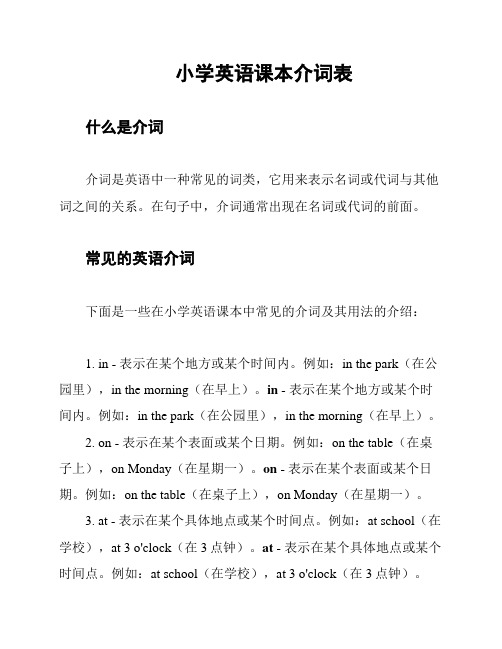
小学英语课本介词表什么是介词介词是英语中一种常见的词类,它用来表示名词或代词与其他词之间的关系。
在句子中,介词通常出现在名词或代词的前面。
常见的英语介词下面是一些在小学英语课本中常见的介词及其用法的介绍:1. in - 表示在某个地方或某个时间内。
例如:in the park(在公园里),in the morning(在早上)。
in - 表示在某个地方或某个时间内。
例如:in the park(在公园里),in the morning(在早上)。
2. on - 表示在某个表面或某个日期。
例如:on the table(在桌子上),on Monday(在星期一)。
on - 表示在某个表面或某个日期。
例如:on the table(在桌子上),on Monday(在星期一)。
3. at - 表示在某个具体地点或某个时间点。
例如:at school(在学校),at 3 o'clock(在3点钟)。
at - 表示在某个具体地点或某个时间点。
例如:at school(在学校),at 3 o'clock(在3点钟)。
4. under - 表示在某个物体的下面。
例如:under the table(在桌子下面)。
under - 表示在某个物体的下面。
例如:under the table (在桌子下面)。
5. above - 表示在某个物体的上面。
例如:above the sky(在天空上方)。
above - 表示在某个物体的上面。
例如:above the sky(在天空上方)。
6. beside - 表示在某物体的旁边。
例如:beside the lake(在湖边)。
beside - 表示在某物体的旁边。
例如:beside the lake(在湖边)。
7. between - 表示在两个物体或人之间。
例如:between the two trees(在两棵树之间)。
between - 表示在两个物体或人之间。
小学英语介词总结

小学英语介词总结小学英语介词总结介词(Preposition )一、一、 概述概述介词是英语中很活跃的词,介词是英语中很活跃的词,一般置于名词之前。
一般置于名词之前。
它常和名词或名词性词语构成介词短语。
它常和名词或名词性词语构成介词短语。
同同一个介词常和不同的词语搭配形成固定搭配,表示不同意义。
一个介词常和不同的词语搭配形成固定搭配,表示不同意义。
二、二、 常用介词的基本用法常用介词的基本用法at ①表示时间:①表示时间: I go to school at seven every day 我每天早上7点去上学。
点去上学。
②表示在某一具体地点:②表示在某一具体地点: He is standing at the bus stop 他站在公共汽车站。
他站在公共汽车站。
③表示动作的方向、目标:③表示动作的方向、目标: Let me have a look at the picture 让我看看这幅图。
让我看看这幅图。
④用于某些固定搭配:④用于某些固定搭配: at once 立刻、马上立刻、马上 at last 最后最后at the same time 同时同时 at first 开始时开始时not at all 一点也不一点也不一点也不about ①表示大约时间:①表示大约时间: I's about six o'clock now. 现在大约6点钟了。
点钟了。
②表示地点;在……周围:周围: Everthing about me is so beautiful 我周围的一切都那么美好。
③关于,对于:③关于,对于: We are talking about the news. 我们正在谈论新闻。
我们正在谈论新闻。
after ①在……之后:之后: After dinner I watch TV. 晚饭后我看电视。
晚饭后我看电视。
②在……后面:后面: He came into the room after me. 他在我后面进了房间。
小学英语介词总结

小学英语总复习小学英语介词总结介词(Preposition)一、概述介词是英语中很活跃的词,一般置于名词之前。
它常和名词或名词性词语构成介词短语.同一个介词常和不同的词语搭配形成固定搭配,表示不同意义。
二、常用介词的基本用法at①表示时间: I go to school at seven every day 我每天早上7点去上学.②表示在某一具体地点:He is standing at the bus stop 他站在公共汽车站.③表示动作的方向、目标:Let me have a look at the picture 让我看看这幅图。
④用于某些固定搭配:at once 立刻、马上at last 最后at the same time 同时at first 开始时not at all 一点也不about①表示大约时间:I's about six o’clock now. 现在大约6点钟了。
②表示地点;在……周围:Everthing about me is so beautiful 我周围的一切都那么美好。
③关于,对于:We are talking about the news。
我们正在谈论新闻。
after①在……之后:After dinner I watch TV。
晚饭后我看电视.②在……后面:He came into the room after me。
他在我后面进了房间。
behind①在……之后:There is a bike behind the tree。
树后有一辆自行车②比……晚,迟于:The train is behind time. 火车晚点了by①在……旁:He is sitting by the bed. 他正坐在床边。
②到……时候:We have learned three English songs by now. 到现在为止,我们已经学会了三首英文歌曲。
③以……方式:I go to school by bus。
- 1、下载文档前请自行甄别文档内容的完整性,平台不提供额外的编辑、内容补充、找答案等附加服务。
- 2、"仅部分预览"的文档,不可在线预览部分如存在完整性等问题,可反馈申请退款(可完整预览的文档不适用该条件!)。
- 3、如文档侵犯您的权益,请联系客服反馈,我们会尽快为您处理(人工客服工作时间:9:00-18:30)。
小学英语常用介词用法摘要:英语介词并不很多,但其用法灵活多样。
掌握常用介词的用法及常见的介词搭配,是学习英语的重点和难点。
关键词:英语介词用法介词是英语中一个十分活跃的词类,在句子的构成中起着非常重要的作用。
介词也是英语中的一个最少规则可循的词类,几乎每一个介词都可用来表达多种不同的含义;不同的介词往往又有十分相似的用法。
因此,要学好介词,最好的方法就是在掌握常用介词的基本用法的基础上,通过广泛阅读去细心地揣摩,认真地比较,归纳不同的介词的用法,方能收到良好的效果。
那么,什么是介词呢?小学常用的介词都有哪些以及它们的用法?一·介词1 介词的含义介词又叫前置词,是一种虚词,用来表明名词,代词(或相当于名词的其他词类,短语或从句)与句中其他词关系的词。
介词不能重读,不能单独做句子成分,必须与它后面的名词或代词(或相当于名词的其他词类,短语或从句)构成介词短语,才能在句子中充当一个成分。
介词后面的名词,代词或相当于名词的部分称为介词宾语,简称介宾。
2介词的分类1)根据介词的构成形式,可将介词分为简单介词,合成介词,双重介词,短语介词四类。
而小学英语中涉及到的介词仅为简单介词和一些短语介词,如:after(在……之后),against(反对),along(沿着),among(在……之中),at(在),behind(在……后面),near(在……附近),into(在……里),in(在……内,用,戴),from(从),for (为,给),except(除……之外),by(乘,在,由,到),on the left (在左边),on the right (在右边)······2)根据介词的意义,可将介词分为表示空间关系的介词,表示时间的介词,表示原因,目的的介词,表示手段的介词和其他介词。
如:表示时间的介词in,on,at,表示方位的介词in,on,to······下文则主要是从介词的意义方面来讲介词的用法。
二·小学常用英语介词1课文中常出现的介词1)about(关于,大约):a book about animals 一本关于动物的书。
2)above(在……上面):a map above the blackboard 黑板上方的一张地图,above all 首要的是。
3)across(穿过,跨过):a bridge across the river 跨过河的一座桥4)after(在……之后):after breakfast 早饭后,after school 放学后,after class 课后5)against(反对):play against them 跟他们比赛。
6)along(沿着):plant trees along the lake 沿着湖边植树。
7)among(在……之中):among the workers 在工人们中间,among the trees 在树丛中。
8)at(在):at home在家,at school 在学校,at work 在工作。
9)before(在……之前):before class 课前,before lunch 午饭前10)behind(在……后面):behind the house 在房子后面,behind the door 在门后。
11)near(在……附近):near the river 在河边,stand near the door 站在门旁。
12)into(在……里):come into the classroom 进入教室,fall into the water 掉进水里13)in(在……内,用,戴):in English 用英语,in a hat 戴帽子,in front of 在……前面,in line 排成一行,in the end 最后,in the open air 在野外,in a minute立刻,in surprise 惊奇地,in time及时,in trouble 处在困难中。
14)from(从):from Monday to Friday 从星期一到星期五,from now on 从今以后。
15)for (为,给):buy some food for lunch 买些午餐的食物,for example 例如,for long 长久。
16)except(除……之外):everyone except Lin Tao 除林涛之外的每个人,every day except Sunday 除星期天之外的每天。
17)by(乘,在,由,到):by plane 乘飞机,by the way顺便说,by then 到那时,by the window 在窗边。
18)between(在两者之间):between the two children 在两个孩子之间,between A and B 在A 和B之间。
19)beside(在……旁边):sit beside her 坐在她身边,beside the river 在河边。
20)below(在……以下):below zero 零度以下。
21)of(……的):the name of the bird 鸟的名字,a map of China一幅中国地图。
22)off(离开):take off one’s clothes 脱掉衣服,go off 走开,turn off 关掉,get off the bus 下公共汽车。
23)with (用,和,带着):go to school with a bag带书包上学,see with one’s eyes 用眼睛看,with one’s help 在某人的帮助下,with pleasure 高兴。
24)without(没有):go out without a coat 没穿上衣服就走出去。
25)until=till (直到……为止):stay in bed until tomorrow 卧床直到明天,wait until ten o’ clock 等到10点钟为止。
26)under(在……下面):under the desk 在书桌下,under the tree 在树下27)to(给、对、到、往):go to school 上学,give a kite to me 把风筝给我,from here to the park 从这里到公园。
28)through(通过,穿过):walk through the gate 走过大门。
29)since (自从):since1995 自从1995年以来。
30)round=around(在……周围):sit round the table 围着桌子坐,round the world 遍及全世界。
31)over(超过,多于):over two years 两年多32)outside (在……之外):outside of gate 在大门外。
33)on(在、关于):on one’s way home 回家路上,on duty 值日,on foot 步行,on top of 在……上面。
on the earth 在地球上。
2 常用英语介词用法比较1)、小学英语介词at,in与on在时间方面的用法at表示时间的一点;in表示一个时期;on表示特殊日子。
如:He goes to school at seven o’clock in the morning. 他早晨七点上学。
Can you finish the work in two days. 你能在两天内完成这个工作吗?Linda was born on the second of May. 琳达五月二日出生。
(1). at后常接几点几分,天明,中午,日出,日落,开始等。
如:at five o’clock (五点),at down (黎明),at daybreak (天亮),at sunrise (日出),at noon (中午),at sunset (日落),at midnight (半夜),at the beginning of the month(月初),at that time (那时),at that moment (那会儿),at this time of day (在一天的这个时候)。
(2). in后常接年,月,日期,上午,下午,晚上,白天,季节,世纪等。
如:in 2006(2006年),in May,2004 (2004年五月),in the morning (早晨/上午),in the afternoon (下午),in the evening (晚上),in the night (夜晚),in the daytime (白天),in the 21st century (21世纪),in three days (weeks/month)三天(周/个月),in a week (一周),in spring (春季)。
(3) on后常接某日,星期几,某日或某周日的朝夕,节日等。
如:on Sunday (星期日),on a warm morning in April (四月的一个温暖的上午),on a December night (12月的一个夜晚),on that afternoon (那天下午),on the following night (下一个晚上),on Christmas afternoon (圣诞节下午),on October 1,1949 (1949年10月1日),on New Year’s Day (新年),on New Year’s Eve (除夕),on the morning of the 15th (15日的早上)等。
2)常用的方位介词有:in on to(1)在范围之内用in ,在范围之外,如果两地接壤就用on,不接壤的用to 。
如:Beijing is in the north of China.Japan is to the east of China .Shanxi Province is on the west of Hebei Province .(2). at表示"在......处",一般指较小的比较具体的地点。
如:He isn't at school. He is at home. 他不在学校,他在家。
(3)in表示"在......内部;在......里面"的意思。
如:What is in the box? 盒子里有什么?(4). on表示"在某物的上面",但两者互相接触。
